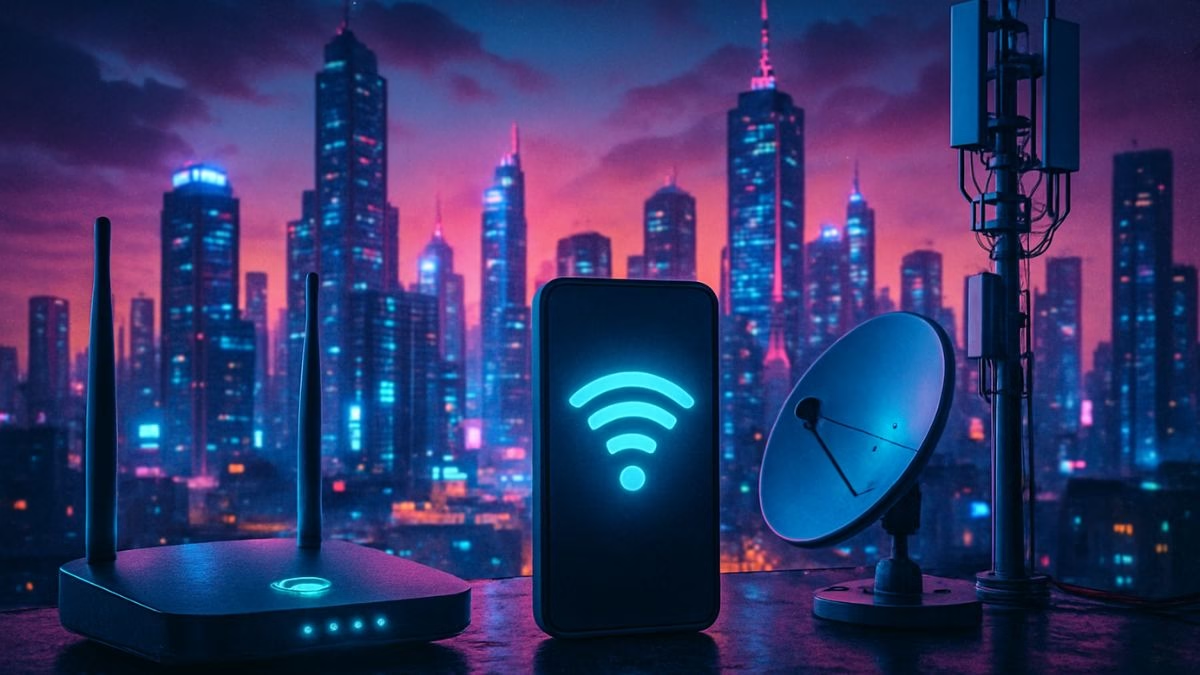Introduction
Welcome to the invisible world! Right now, all around you, silent signals are zipping through the air, carrying everything from this webpage to phone calls and your favorite songs. It feels like magic, but it’s actually incredible science. Have you ever stopped to think about how your Wi-Fi router sends a movie to your tablet, or how your wireless earbuds talk to your phone?
This quiz is your key to understanding that magic. It’s not a test, but a journey of discovery. We’re going to break down how wireless technology works in a simple, fun way. You’ll learn the language of signals—what terms like ‘frequency’ and ‘bandwidth’ really mean, how data ‘piggybacks’ on invisible waves, and what makes Wi-Fi, Bluetooth, and 5G different. By the end, you won’t just use wireless technology; you’ll understand it. So, let’s tune in and decode the secrets of the airwaves together!
Learning Quiz
This is a learning quiz from English Plus Podcast, in which, you will be able to learn from your mistakes as much as you will learn from the answers you get right because we have added feedback for every single option in the quiz, and to help you choose the right answer if you’re not sure, there are also hints for every single option for every question. So, there’s learning all around this quiz, you can hardly call it quiz anymore! It’s a learning quiz from English Plus Podcast.
Quiz Takeaways: Decoding the Airwaves – How Wireless Works
Hello and welcome. Think about your day so far. Did you check your phone? Listen to music on wireless headphones? Connect your laptop to Wi-Fi? We live our lives surrounded by an invisible symphony of signals, a constant, silent conversation happening in the air all around us. It feels like pure magic, but today, we’re going to pull back the curtain and reveal the amazing science that makes it all possible. We’re going to decode the airwaves.
The story of all wireless technology starts with one thing: electromagnetic waves. Don’t let the long name intimidate you. These are simply waves of energy that can travel through space. The light from a lamp is an electromagnetic wave. The X-rays at a doctor’s office are, too. And so are the radio waves that carry our data. They are all part of one giant family, the electromagnetic spectrum, and the only real difference between them is their frequency—how fast they vibrate. We use different frequency “bands,” or sections of this spectrum, for different purposes, like separate lanes on a celestial highway, to keep everything from crashing into each other.
For any wireless communication to happen, you need two things: a transmitter to send the signal, and a receiver to catch it. A two-way device, like your phone, has both. But how do we get your data—your voice, a photo, a webpage—onto one of these invisible waves? This is the most crucial step, and it’s called modulation. Imagine you have a steady, boring carrier wave, like a constant hum. Modulation is the art of changing that hum to carry a message. You can change its height, or amplitude—that’s AM radio, or Amplitude Modulation. Or you can change its pitch, or frequency—that’s FM radio, Frequency Modulation. For digital data, we use more complex versions of this, but the principle is the same: we alter the wave in a specific pattern to encode the ones and zeros of our digital information.
Once the data is modulated onto the wave, the transmitter amplifies it and sends it on its way from an antenna. As this wave travels, it spreads out and gets weaker, just like the ripples from a stone tossed in a pond. This is why your Wi-Fi signal is weaker in the basement than right next to the router. Eventually, the faint wave reaches the antenna of a receiver. The receiver’s job is to do the reverse of the transmitter. It tunes into the specific frequency, picks out the faint, modulated signal from all the other noise, and demodulates it—translating the patterns in the wave back into the original data you can see, hear, or use.
Now let’s look at the technologies we use every day. Think about your home Wi-Fi. Your router is a transmitter and receiver. It creates a local network, your own personal bubble of internet. When you see options like 2.4 GHz and 5 GHz, you’re choosing between two different frequency bands. The 2.4 GHz band is like a crowded country road—it has a longer range and is good at going through walls, but it’s slower and more prone to interference from things like microwaves and cordless phones. The 5 GHz band is like a modern, multi-lane highway. It’s much faster and less crowded, but its higher-frequency signal doesn’t travel as far and gets blocked more easily by obstacles.
Then there’s Bluetooth. Bluetooth is designed for one thing: short-range, low-power communication. It’s perfect for pairing your headphones, keyboard, or smartwatch to your phone without draining everyone’s batteries. It uses the same 2.4 GHz band as some Wi-Fi but employs a clever technique called frequency hopping, rapidly jumping between different channels to avoid interference. An even more specialized technology is NFC, or Near Field Communication. This is what you use for tap-to-pay. Its range is intentionally tiny—just a few centimeters—as a security feature, ensuring you only pay when you mean to.
What about when you leave your house? That’s when your phone switches to the cellular network. The genius of the cellular system is that it isn’t one giant, powerful tower covering a whole city. Instead, the land is divided into a honeycomb of smaller areas called “cells,” each with its own tower. As you drive from one cell into another, the network seamlessly hands your signal off from the old tower to the new one, allowing for continuous coverage over vast distances. The different generations—3G, 4G, and now 5G—represent massive upgrades in how efficiently this system can modulate data, giving us faster speeds and lower latency. Latency, by the way, is just a word for delay—the lag between asking for data and getting it, which is crucial for things like online gaming and video calls.
Of course, with all this data flying through the air, security is paramount. That’s where encryption comes in. Before your router sends your data, it scrambles it into a secret code using your Wi-Fi password as the key. Only a device that has the same key can unscramble it. This ensures that even if someone can “hear” your Wi-Fi signal, all they’ll get is meaningless gibberish.
So, from the first scientific proof of these waves by Heinrich Hertz in the 1880s, to Marconi’s first radio broadcasts, to the 5G-powered Internet of Things today, the story of wireless is one of human ingenuity. It’s a story of learning to speak a new, invisible language. It’s not magic, but it is a kind of miracle—a symphony of transmitters, receivers, modulation, and frequencies, all working in perfect harmony to connect our world. And now, you know how to listen in.










0 Comments